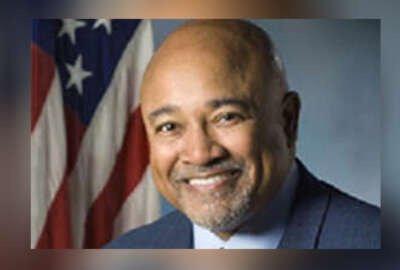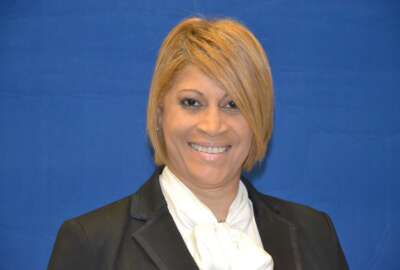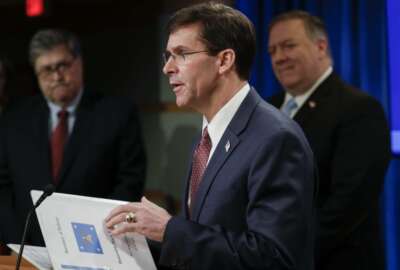
Treasury initiative has helped back minority owned banks
A program launched by Treasury a couple of years back has helped keep banks in minority hands while strengthening their finances.
Best listening experience is on Chrome, Firefox or Safari. Subscribe to Federal Drive’s daily audio interviews on Apple Podcasts or PodcastOne.
Only a tiny portion of the more than 5,000 banks and financial institutions in the United States are owned by minorities. Only 149, to be exact. But a Mentor Protégé program launched by Treasury a couple of years back has helped keep those banks in minority hands while strengthening their finances. Our guest has earned a finalist slot in the Service to America Medals program this year for his work in the program. Assistant commissioner for revenue collections management at the Treasury Department, Corvelli McDaniel, joined Federal Drive with Tom Temin to discuss.
Interview transcript:
Tom Temin: Mr. McDaniel, good to have you on.
Corvelli McDaniel: Thank you so much for having me.
Tom Temin: Now you are more than just a participant in this program to kind of preserve ownership of minority owned banks, you actually conceived the idea or helped conceive it. Tell us tell us the goals you’re trying to reach here.
Corvelli McDaniel: Yes. It was my vision and really felt an obligation to do my part, based on the position that I’m holding at the Treasury Department to advance the cause of small banks and create more of a diverse network, a more inclusive network of essentially business partners that the Treasury does business with that would result in a richer network, a more diverse and capable network of banks that support Treasury’s needs.
Tom Temin: And we should also point out that Dr. Lorraine Cole, the Treasury’s Chief Diversity and Inclusion officer is your co finalist in this — she’s not on the interview, but we wanted to acknowledge her. And so how do you go about strengthening that network, what can Treasury do to strengthen the I guess the financial efficacy and managerial strength of the minority owned banks, of which there’s less than 150?
Corvelli McDaniel: That’s right. We must first recognize that these banks are capable of resourceful, they have a network of talented employees and unique abilities that have an opportunity to bolster and further Treasury’s objectives around its mission and its responsibilities to citizens and businesses across the US. So there must be an awareness of this group of banks and their capabilities, the talent they represent, the resourcefulness that they have had to exemplify in order to survive and support their community, a source of leadership. If we’re aware of that, then it becomes a good business decision to create partnerships with such organizations because their strengths only strengthen the Treasury Department. And also this has to ultimately be real in terms of opportunities for the small banks. It’s about economic opportunity. And so the Treasury Department does its share business with large banks as a matter of course, and extending those opportunities to smaller banks means real economic impact for these these smaller organizations, and that only strengthens their ability to serve their customers and small businesses across the US and local communities.
Tom Temin: And briefly, what does Treasury do with banks large and small? What is the relationship there?
Corvelli McDaniel: You know, we have a unique relationship based on special authorities to designate banks, they serve as financial agents. That is a unique fiduciary relationship, different from a contractor, different from the traditional vendor organization. These are financial agents. They’re actually representing Treasury and its values, its responsibilities in a unique way. So having that designation, and that is normally through a competitive process of some type, that unique nature of the relationship with Treasury sets banks apart when they serve in that capacity
Tom Temin: And having described these smaller banks, minority owned banks as you have, what then is the benefit that they will get from the mentor-protege relationship with some of the biggest banks in the country.
Corvelli McDaniel: This is the exciting part of the entire concept that the sky really is the limit here. It has been really overwhelming to see the large banks take ownership of this concept of mentor-protege and extended far and beyond really what we even envisioned in terms of the access these small banks have to subject matter experts, to experience, to the technology, the know how, the influence of these larger banks. It started with the vision of alright you would be trained up prepared to take on roles as a financial agent, opportunities that would not normally come short of a mentor-protege relationship. But so not only Treasury opportunities, but the exciting part has been what mentor banks have done beyond training and preparation to serve on Treasury opportunities. Whether that’s platforms, access to information on mergers and acquisitions, access to capital, liquidity challenges, just the sheer access to the range of things that a major bank does day to day with the basis being a sincere, authentic relationship really to organizations that really want to work together, and a mentor that is committed fully committed at the highest level to being there for this protege and working in partnership. It represents really potential that is unlimited.
Tom Temin: And how did you convince the banks that are the mentors to do the protege relationship, when in some sense, all banks are competing?
Corvelli McDaniel: Very true. And that was really, I think, part of the important foundation that was laid coming to a meeting of the minds that it’s okay not to be competitors, right. Let’s turn that paradigm on its head and look at the potential of what two banks can do together. It really was, you’re right, a sea change in terms of the mindset, because it is a competitive environment. But banks saw the potential of when they looked into the future and realizing that, hey relationships are important, strategic partnerships, alliances, coalitions. That is that is going to be how they survive. And the more diverse those partnerships, those coalitions are, the stronger they are at achieving some of their strategic goals. You know, these major banks still have a vision for the future. They have their own designs on supporting communities, giving back, expanding their operations in certain areas, and partnering with some of these smaller banks, minority owned banks, just resonated with them. Not to mention, I think, at the core, diversity and inclusion, partnering with minority owned banks, small banks really kind of hit home in terms ofvsome of their own corporate principles, their own corporate expectations and goals. So they really saw a way to bring it together with Treasury’s program around really getting behind this program. It has been phenomenal, quite frankly. But it did take, it was a labor of love involved in hey we’ve got to socialize this concept. We’ve got to really meet one on one and talk this through, but the principles of the mentor-protege program really resonated deeply and when I get past the competitive nature of things. So the value of the partnership, they really took it to a very high level.
Tom Temin: And how many mentor protege relationships exist now and what’s your goal, say for the coming year?
Corvelli McDaniel: No, we have currently five mentor banks committed and a total of 10 mentor-protege relationships. So we feel like really this is moving in a very positive direction. And our goal is to see, ultimately, about 25 mentors, major banks serve as mentors, and 30 or more mentor-protege relationships to really support our program.
Tom Temin: Corvelli McDaniel is Assistant Commissioner for revenue collections management at the Treasury Department. Thanks so much for joining me.
Corvelli McDaniel: Thank you for having me. I really appreciate it.
Copyright © 2025 Federal News Network. All rights reserved. This website is not intended for users located within the European Economic Area.
Tom Temin is host of the Federal Drive and has been providing insight on federal technology and management issues for more than 30 years.
Follow @tteminWFED





